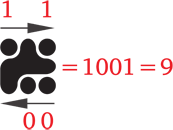
The Ineon alphabet was devised in May and June 2012 by Martin Harvey. The original idea was for a writing system that would look imposing inscribed on a monument and could also be used to insert cryptic messages/in-jokes into his artwork. However, while playing around with Adobe Illustrator he realised that for other purposes, a more decorative, rounded script would look better. The former became Ineon Monumental, the latter Ineon Rounded.
As mentioned above, the script is phonetic, but only up to a point - otherwise it would be useless for writing any other accent of English than that of its inventor. It is not intended to make writing faster, and can therefore be thought of as something of an artistic endeavour.
The name Ineon is derived from a more phonetic respelling of inneon, the word for "nine" in the English Romani language. Each character can be thought of as being divided up into a grid of nine smaller squares, with consonant lines drawn along the grid lines and vowel/number dots occupying one or more squares. This is particularly evident in the case of Ineon Monumental.

Positions of lines as related to consonantal qualities

*lateral and palatal share a position as the inventor was running out of places to put lines.

*the phoneme /x/ does not, of course, belong to Received Pronunciation, but, as the inventor is something of a scotophile, he cannot abide to hear the word “loch” being pronounced as “lock”
**this is a mistake. The letter representing the phoneme /t/ should actually look like that representing the phoneme /ŋ/, albeit rotated 90° anti-clockwise. It is, however, a mistake that is never going to be rectified, as the inventor has had a T-shirt made with Ineon characters on it. Oh well, nobody's perfect.



As mentioned above, the design of the numerals is based on the positions of the 1s and 0s in binary, although the counting system is base 10.



All human beings are born free and equal in dignity and rights.
They are endowed with reason and conscience and should act towards
one another in a spirit of brotherhood.
(Article 1 of the Universal Declaration of Human Rights)
Constructed scripts for: Ainu | Arabic | Chinese languages | Dutch | English | Hawaiian | Hungarian | Japanese | Korean | Lingala | Malay & Indonesian | Persian | Tagalog / Filipino | Russian | Sanskrit | Spanish | Taino | Turkish | Vietnamese | Welsh | Other natural languages | Colour-based scripts | Tactile scripts | Phonetic/universal scripts | Constructed scripts for constructed languages | Adaptations of existing alphabets | Fictional alphabets | Magical alphabets | A-Z index | How to submit a constructed script
[top]
You can support this site by Buying Me A Coffee, and if you like what you see on this page, you can use the buttons below to share it with people you know.

If you like this site and find it useful, you can support it by making a donation via PayPal or Patreon, or by contributing in other ways. Omniglot is how I make my living.
Note: all links on this site to Amazon.com, Amazon.co.uk
and Amazon.fr
are affiliate links. This means I earn a commission if you click on any of them and buy something. So by clicking on these links you can help to support this site.
[top]